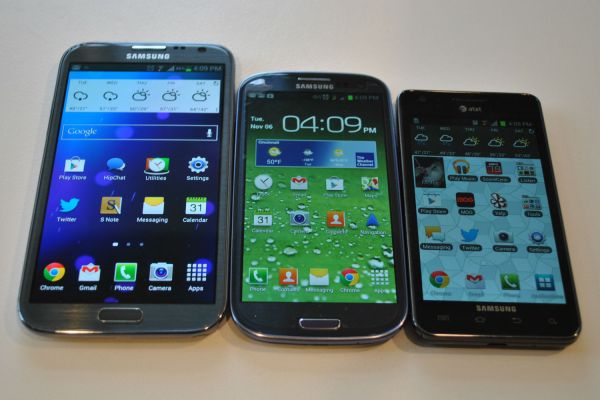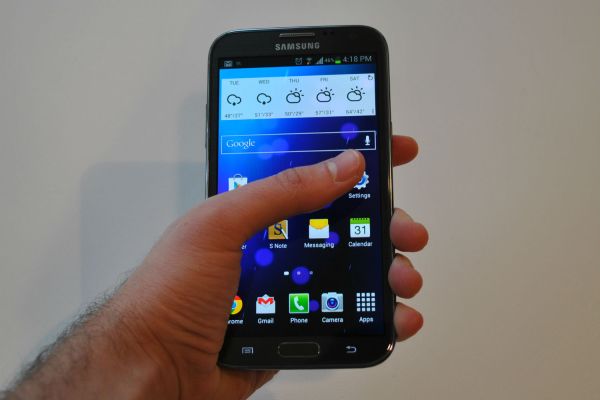There was a time when I thought 4 to 4.3 inches was the ideal screen size for a smartphone. This was before Apple upsized its iPhone 5, but after other phone makers had starting creeping into the 4.7- to 4.8-inch range. It seemed to me that smartphones were getting too big for average-sized hands, and that phone makers had gone mad in a game of “mine is bigger.”
But then I spent a week using nothing but Samsung’s Galaxy Note II, a smartphone-tablet crossover with a whopping 5.5-inch display. It’s been a fun experience, but it’s also tweaked my thinking; now, even 4.8-inch screens seem reasonable, and anything less feels insufferably puny.
Granted, I’d always been accepting of the fact that some people might like phones with gigantic screens. In my review of the original Galaxy Note, which only launched nine months ago on AT&T, I concluded that the phone should find a niche, though I didn’t consider myself part of it. Somehow in the course of using the Note II as my only phone for a week, my feelings have changed.
The fact that the Galaxy Note II is so much better than its predecessor might have something to do with it. This is largely due to the software, which is based on Android 4.1, codenamed Jelly Bean. Smoothness was the main focus for this version of Android, and it really shines on the Note II. Every swipe through the home screen is just as fluid as the iPhone–for a long time the high-water mark of interface fluidity–even with a full array of widgets and an animated wallpaper. I’ll go so far as to say it’s the smoothest Android phone I’ve ever used.
(MORE: Samsung’s Galaxy Note II: U.S. Carriers Show the Phablet Some Love)
Samsung’s hardware probably played a role in the Galaxy Note II’s newfound pep as well. This is one of the first smartphones in the United States with a quad-core processor, and it also has 2 GB of RAM to keep things humming along. I never had any performance issues when watching videos, playing games or just moving from one app to another. Shutter times on the phone’s 8-megapixel camera were practically immediate.
The main attraction, of course, is that gigantic 5.5-inch, 1280-by-720 resolution display. That may sound like a boost over the 5.3-inch, 1280-by-800 resolution display in the original Galaxy Note, but it’s actually more of a shift. The Note II’s display uses a 16:9 aspect ratio, so it’s taller and narrower than the original 16:10 note, and the pixel density (and overall number of pixels) is lower. In the real world, the difference in displays is subtle.

When you hold the Galaxy Note II up against any other smartphone, however, the difference is drastic. Compared to the iPhone 5, the Note II provides roughly 0.75 inches more space horizontally, and about 1.25 inches more space vertically. Although the screen resolution is the same as many other high-end Android phones–and the pixel density is lower–there’s still something glorious about the Note II’s roomy display, especially for videos, games and web browsing.
The size of the phone provides another benefit: It leaves room for a big battery. I didn’t do any standardized testing, but when using the Note II regularly for phone calls, browsing, GPS navigation, photography, streaming music and the occasional game or video, I was often able to leave it off the charger for two whole days at a time. It’s hard to imagine any situation where the Note II wouldn’t at least be able to get through a full day of rigorous use, and a 48-hour span is definitely doable.
(MORE: Hands On with Samsung’s Galaxy Note II: Even Bigger Screen, Nicer Pen, More Refinement)
But is the Note II too big to actually carry around? Not for me. I tried it in a variety of jeans pockets, both dressy and casual, and never felt uncomfortable, though the phone can leave a notably large impression (cue the banal jokes). It helps that the Note II is fairly svelte, measuring 0.37 inches thick with a gently curved design. (In terms of looks, it’s similar to the Galaxy S III, with softly rounded edges and a glossy plastic rear panel.)
The biggest problem with the Galaxy Note II is the one that’s inherent to its size: You cannot comfortably use it with one hand. Sure, you can flip through the home screen and scroll through apps with your thumb, but good luck tapping something at the top of the screen, or reaching beyond the home button to either the back or menu buttons (depending on which hand you’re using). A few times, I almost dropped the phone while wrangling with it one-handed. More often, my palm would accidentally tap something on the edge of the screen as I tried to reach across with my thumb. As with the original Note, it’s a tradeoff.

Of course, Samsung is still pushing the “S Pen” stylus as a selling point for the Galaxy Note II, and I still think it’s a gimmick. The stylus itself is larger, and therefore easier to use, and the phone includes a few more pen-optimized applications than its predecessor, including a pressure-sensitive version of Sketchbook Mobile. In my normal use, though, it was rarely easier to pull the stylus from its holster than it was to just keep using my fingers. Also, the Note II’s physical back and menu buttons don’t detect the stylus, so even when you’re using it, you’ll still need to tap with your fingers to get around.
I do have a few other nitpicks with the Galaxy Note II’s software, mainly where Samsung tries to overreach with unnecessary features. For instance, the keyboard has a one-handed mode that squishes the keys toward one side of the screen. It’s clever, but too easy to invoke by accident (I’m not even sure how), and once enabled, the only way to turn it off is through the keyboard’s settings menu, as far as I could tell. The keyboard has other frustrations, notably the lack of a dedicated button for voice input–it’s instead combined with the clipboard and other keyboard options in an all-purpose input button–though I did like how number keys are perched above the letters.
Also, Samsung’s shameless Siri clone, known as S Voice, doesn’t bring much to the table. You reach it by double-tapping the home button, but I’d much rather assign that command to regular Google voice search. You can, at least, access Google Now by holding the menu button, but the use of two different voice assistants, one inferior than the other, just adds confusion. At this point, a few bad software decisions here and there are par for the course with Android phones, and the Note II is no different.
Overall, though, the Galaxy Note II is an excellent device, however you want to classify it. In my week with this phone-tablet crossover, I’ve noticed that I’m using my Nexus 7 tablet less, and I’m dreading the idea of going back to the smartphones that I once thought were just the right size. There’s room for a device that straddles the line between both, and Samsung is showing everyone how it’s done.

